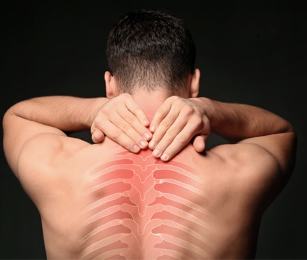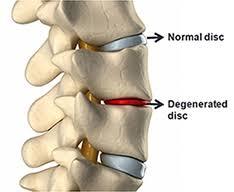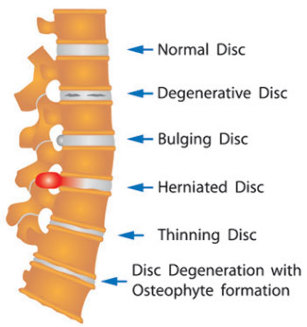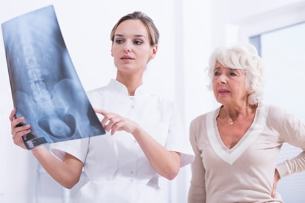
The disease of osteochondrosis is the most common of all diseases of the spine. As well as the osteochondrosis, directly is a dystrophic-degenerative diseases of the defeat of the disks located between the vertebrae, then, as a consequence, this leads to their permanent change in the structure, as well as the form of the own discs.
With the increase of the age of the person these changes in your spinal column is developing more and more, and at the age around 40...45 years of the osteochondrosis is sick almost all. By itself, the osteochondrosis of breastfeeding and of the spine develops much less frequently than, for example, the lumbar or cervical parts of the spine, as well as the vertebrae in him much less active than in other vertebrates areas. In addition, the area of the back in the area of the rib cage has more developed the corset of muscles that performs the support of the spine in the division much better than others.
What is this chest of osteochondrosis?
Chest of osteochondrosis directly is a package of disks between the vertebrae and, at the same time the decrease of its thickness and, as a consequence, the subsequent pinched nerve endings that are found here in intercostal area of the chest of the person.
However, once more, note that, since the fixation of the ribs in the man is very hard, the department of the spine in the chest area less susceptible to the disease osteochondrosis.
Normally in the process of the pathology is that they involve the discs between the vertebrae of breastfeeding and of the division, which includes twelve vrtebras. But more often the osteochondrosis of breastfeeding and the division of the pathological changes that occur in Wernigerode the vertebrae. There are various degrees of defeat native of the osteochondrosis, and then we will examine it in more detail.
Predisposing factors are the development of the breastfeeding and osteochondrosis
The exact causes of the emergence of osteochondrosis of breastfeeding and the division of modern science until the end have not yet been established. At this point they are divided into medicine the following predisposing factors are, or so called risk factors:
- hereditary predisposition;
- the excess physical load;
- injuries of the spine, such as, for example, falls or injuries;
- the changes that occur with age in the intervertebral disks, and that will lead to the decrease of hydration in the tissues of the disc;
- the violation of blood circulation in the chest area.
The causes that contribute to the disease osteochondrosis of breastfeeding and of the spine
The main degree of development of the disease osteochondrosis, in general, contributes to physical inactivity, that is to say, the lack of loads of muscle, which leads to a weakening of the functions of the muscular system of the corset and, as a consequence, to an increase of the pressures in the spinal discs and ligaments.
Other additional reasons for the development of breastfeeding and of osteochondrosis are also:
- the hypothermia of the body;
- the presence of chronic diseases of the stress situations;
- migrated from the infection;
- harsh working conditions a physical;
- problems have arisen, hormone in the body;
- the violation of a process of exchange of substances in the body;
- the presence of birth defects of the spine.
During the influence of all these factors, or sometimes even one of the discs between the vertebrae with the passage of time will develop dystrophic degenerative processes are irreversible:
- purposee nucleus intervertebral disc gradually starts to lose fluid, which is separated from them to ensure the lubricity of the functions that, ultimately, significantly reduces the depreciation function of this disk.
- in addition, the fibrous ring of the vertebrae, given the increase in the load on him, he becomes more vulnerable, leading to its progressive deterioration.

The symptoms of breastfeeding and of the osteochondrosis and its signs
The clinical symptoms of the clinic of osteochondrosis depend on the factors:
- age of the patient;
- the degree of severity of the disease;
- the phase of the degenerative disc disease thoracic spine: the remission or exacerbation of the.
The main features of osteochondrosis of breastfeeding and the division are:
- the pain in the chest in the area of the spine, the so-called - Dorigo;
- painful of the damage in the nerve endings of the spinal cord – radiculopathy;
- abdominal syndrome;
- heart syndrome or changes in the heart muscle, with their pains, the persistence, even under the effect of nitroglycerin;
- pulmonary syndrome, in the form of stagnation in the lungs, with signs of hypoxia, that is to say, to asphyxia.
The increase of the temperature of the body of the sick person when the osteochondrosis is not observed, which is also a direct differential diagnosis of a symptom. Dorsalgia in the area of the rib cage indicates in the appearance of cracks in the fibrous ring and the deformation pulpous nucleus. To make felt, the pain of the area of the rib cage to accumulate.
In addition, the typical symptoms of clinical osteochondrosis of the compressive myelopathy, that is to say, the deformation of the nerve endings, are:
- the sensation of "chills" - paresthesias;
- the pain of the march in this way of the nerve;
- the reduction of the sensitivity to temperature and touch;
- the breach in the vertebral column motor function.

The degree of the maternal disease of osteochondrosis
The different degrees of the maternal disease of osteochondrosis are characterized by each of his pathology is, of each of which are inherent only their clinical signs. The modern medicine, there are four degrees of osteochondrosis of breastfeeding and the division and, in consequence, in four periods of its development. Let's look in more detail.
First degree, for which the characteristic is that, in fibrous rings produce cracks, which subsequently penetrates purposee core. This period of development of the maternal disease of osteochondrosis is characterized by the following features:
- the appearance of pain in the spine at the place of your defeat, but not beyond the location of the onset of the disease;
- these pains can be used as a permanent character, as being in the form of prostrelov;
- may occur convulsive and muscle contraction, accompanied by pains in the heart area.
Second degree, as the period of development of the breastfeeding and the osteochondrosis, is characterized by a high aspect intervertebral mobility with the following clinical manifestations:
- appear subluxations in the division of the spinal column;
- the pain intensifies during movement;
- it appears the trouble to the length of the persistence of the position.
The third degreeis characterized by a period when it is broken fibrous ring and beyond she leaves purposee core. In this period of the disease osteochondrosis of breastfeeding and of the spine begin to appear intervertebral hernia, clinical signs of which are quite heavy. Namely – neuro-vascular, musculo-tonic and reflex-dystrophic.
In addition to a third degree of osteochondrosis of breastfeeding and the division is a characteristic of change of the following states of the vertebral column:
- the weakness of the fixation of the provisions of the vertebral column;
- limitation of the mobility backbone of the division, is manifested in the form of kyphosis or scoliosis.
Fourth grade, is related to the period in which dystrophic-degenerative process affects all structures that are found here around the spine. In this pathological involved yellow, interspinal, and other ligaments and structures surrounding the spine, it causes the fibrosis. In this period of the maternal disease of osteochondrosis, clinically observed, the so-called state of remission.
The complications that may occur if the osteochondrosis
To deepen the progression of the maternal disease of osteochondrosis, it is possible the development of collateral complications, such as:
- the inflammation of the nerve endings of the spinal cord;
- the occurrence of intervertebral hernias;
- the development of vascular dystonia;
- the development of the herniation Schmorl's;
- disease spondylosis;
- the proliferation of bony outgrowths - osteophytes;
- a substantial reduction in spinnomozgovogo of the channel.
It should be noted that the degree of severity complications arise when the osteochondrosis is totally dependent on the pace of progress in the process of the incidence of the disease and, of course, of the effectiveness of the methods of treatment of osteochondrosis of breastfeeding and of the spine.

The diagnosis of breastfeeding and of osteochondrosis and their methods of
In practice use several methods for the diagnosis of breastfeeding and of the osteochondrosis. Of these the most common is the x-ray, whose results are sufficiently informative. The signs of breastfeeding and of the osteochondrosis, to identify in this study, are:
- violated the contours of the discs between the vertebrae;
- the edge of the cover disks acquired a rolling nature;
- the discs of the column changed its shape;
- have emerged osteophytes bony pathological expansion;
- enlarged and sharpened hooked the rods to the vertebrae;
- the body vrtebras changed from its normal form;
- significantly reduced the size of the height of the discs between the vertebrae;
- have been formed from a herniated disc between the vertebrae.
In some cases, we practice the diagnostic method of breast-feeding, and of osteochondrosis through radiopaque of the research, defines the following symptoms of this disease:
- in the case of the execution of the pathology is the contrast, fills the disc between the vertebrae in its entirety;
- with the help of a contrast medium, are visible the outlines of a pulpous nucleus of uneven;
- with the destruction of intervertebral disc, in great measure, a contrast, penetrates beyond its limits, until the penetration into the spinal canal.
The treatment of the osteochondrosis of breastfeeding and
The treatment of breastfeeding and the osteochondrosis is perhaps one of the following methods applied taking into account the results of the analysis of breastfeeding and of the osteochondrosis, namely:
- conservative-traditional treatment;
- the treatment of breastfeeding and of the osteochondrosis with traction;
- operational-of the surgical intervention.
Nothing new, of course, here has not yet been invented, and as such, the treatment of breastfeeding and of the osteochondrosis, called conservative, is already traditional for the treatment of any type of degenerative disc disease. In any case, it is preferable to the always-conservative-medical method of treatment of breast-feeding, and of osteochondrosis through allocations of non-steroidal anti-inflammatory medicines for the outrage of the sensations are painful. It should be noted that these processes medicines that are very well resolved the inflammatory processes, as well as take care of the swelling and thus reduce the process of collapse of the nerve root. In the more complex cases of the maternal disease of osteochondrosis, the therapist may assign additional for a number of drugs, for example, the powerful pain relievers, and muscle relaxants, which block the occurrence of muscle spasms.
When the pain is removed, or managed to cut, that is to say, in the time of the referral, it is assigned an advanced physical therapy treatment, and, in addition, physiotherapy and massage. The main tool in the fight, and prevention of the disease in the treatment of physiotherapy, magnet therapy is through the specific treatment of instruments.
In addition to the above cases, for the treatment of breastfeeding and the osteochondrosis can be applied with success and traction treatment, that is to say, the treatment of breastfeeding and of osteochondrosis through a traction. In this method, paravertebral muscles, tissues and ligaments suffer the majority of the waste, which leads to an increase in the intervertebral distance. Even and-a-half millimeters as would be sufficient to reduce the inflammation, remove the oppression, as well as the relief of tension, in the adjacent to the spine of the muscles.
And here surgical intervention is advisable only when the previous methods of treatment of the clinic of the osteochondrosis does not give the desired result.




























